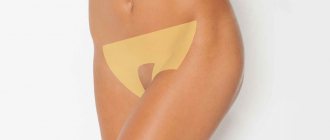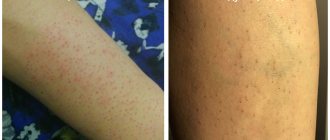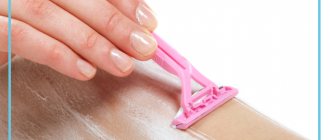03/01/2021
With laser hair removal you can permanently get rid of unwanted hair on any part of the body. In order for the results of the technique to be as positive as possible, it is necessary to properly prepare for it before, as well as provide competent care after. The doctor will tell you during your first consultation what you can’t do after laser hair removal, and what restrictions are important to strictly observe. The patient must responsibly follow all the specialist’s recommendations, otherwise the risks of negative post-procedure consequences increase, which are much more difficult and longer to deal with.
What is prohibited and for how long?
After laser hair removal, the skin should not be subjected to unnecessary stress, since during the recovery period the epidermis remains sensitive, prone to irritation and inflammation. After laser hair removal, the skin is more susceptible to pigmentation and is more sensitive to aggressive sun rays. Therefore, in the first two to three weeks after laser hair removal, you should not sunbathe, visit a solarium, or stay in direct sunlight for a long time. In the summer, before going outside, you need to treat your skin with sunscreen with the maximum degree of protection.
Baths, saunas, and swimming pools are strictly contraindicated after laser hair removal. Exposure to hot steam and chlorinated water also negatively affects the condition of the skin, contributing to the occurrence of irritation, hyperemia, swelling, and peeling. Therefore, it is better to abandon these procedures within 1.5 - 2 weeks.
Any procedures involving exposure of the skin to abrasive particles are prohibited:
- peelings;
- scrubbing, etc.
During the entire course of laser hair removal, it is prohibited to remove growing hairs with wax or sugar paste, as these products have a negative effect on the condition of the skin, contribute to its injury, and can lead to serious complications during the next session.
Effect of laser on skin
In most cases, the skin after a laser hair removal session looks healthy and undamaged, but we must not forget that it has been subjected to serious stress, so it requires restoration and careful care. Our center’s specialist gives basic recommendations for skin care to the client at the stage of preparation for the hair removal procedure. At the same time, the recommendations are both general and purely individual in nature, since the level of sensitivity and characteristics of the epidermis differ for each person.
Any side effects in our work are excluded, since we select an individual approach to each client thanks to the professionalism of our specialists. Before prescribing a course of hair removal, our master clarifies the presence of contraindications (chronic heart pathologies, oncology, pregnancy), takes into account the phototype and other characteristics of the skin, planning the principles of working with a specific client. The seriousness of our approach allows us to carry out laser hair removal as efficiently as possible without consequences for your skin.
To receive detailed advice from our specialist and directly conduct a laser hair removal course, today you can visit our office, located in the center of Moscow at the address: st. Alexandra Solzhenitsyn 1/5. More detailed information about the center's services can also be found in the laser hair removal section.
Relative prohibitions after hair removal
For about a day after the procedure, you should refrain from showering or you need to isolate the area exposed to the laser. Water during hygiene procedures should not be hot, a comfortable temperature is 38 – 40 °C.
For about another 7–10 days, it is forbidden to rub the treated areas with a washcloth. For hygiene, it is recommended to use soft, hypoallergenic shower gels without chemical additives.
After two weeks, the treated hairs will gradually begin to fall out. To speed up this process, you can use a light texture scrub. It is still forbidden to treat the skin with large abrasives or rub it with a hard washcloth.
Do not use skin care products containing alcohol. It is also not recommended to massage the epilation area, as intense friction can cause irritation and redness of the skin.
Contraindications for laser hair removal
Laser hair removal is not for everyone, although it is effective. It is not recommended if there are any contraindications related to health conditions.
Diseases and restrictions for which laser hair removal of legs is not permitted:
- Acute phase of diabetes mellitus. In this condition, carbohydrate metabolism is disrupted, which leads to the appearance of ulcerations and wounds. In addition, with diabetes mellitus, regeneration of the epidermis occurs much more slowly.
- Taking antibacterial agents. The procedure is allowed only 2 weeks after completion of the course of treatment.
- Carrying out hormonal therapy. During this period, the desired effect may not be obtained, since hormones have a strengthening effect and accelerate hair growth.
- Pregnancy and breastfeeding. In this condition, the woman’s hormonal background changes, and therefore hair removal will be ineffective. The procedure can be performed at the end of lactation.
- Infectious or viral diseases of the skin of the legs. In this case, the laser can cause dangerous complications.
- Tumors of a malignant nature.
- Epilepsy.
- Diseases of the circulatory system.
- Acute phase of pulmonary tuberculosis.
- Acute period of cardiovascular diseases.
Warts and papillomas are a relative contraindication to laser hair removal. Whether or not to perform the procedure in this case is determined by a specialist depending on the individual characteristics of a particular client.
If the skin of the legs is damaged, there are scratches, abrasions, burns, hair removal is not recommended. You must wait until the damage has completely healed. Laser radiation does not affect gray hair, since it contains voids instead of colored melanin. In addition, laser is ineffective on light shades.
FAQ
Yes. The main condition for laser hair removal is dark hair. If you have white, red, or gray facial hair, it will not be removed by the laser.
Unwanted facial hair is a problem not only for men, but also for women. Hair in this area looks unsightly and spoils even a very attractive appearance. Laser hair removal is one of the most modern, popular and effective ways to eliminate this problem.
Facial hair grows very quickly (remember men, many of whom are forced to shave every day), and it is necessary to constantly fight for smooth skin. Women have to pluck out regrown hairs on their eyebrows almost every day, and newly epilated mustaches become noticeable within a few days after the procedure.
Therefore, it is important that the method used gives as long an effect as possible, ideally for life. None of the above methods can boast of this, unlike laser hair removal, which retains, if not lifelong, then at least long-term effects.
Laser hair removal technology is based on the fact that a narrow beam of radiation is directed from a close distance onto the skin. It causes the pigment at the hair root to “boil,” which destroys the hair follicle and the blood and lymphatic vessels that feed it. A hair with a dead root falls out after a couple of weeks.
Sometimes the downside of laser facial hair removal is its supposed soreness. But actually it is not. The procedure with the ruby laser, which entered the beauty industry in the sixties, was painful. Due to the relatively short wavelength (694 nm), it only worked on dark hair and only on light skin. And he even left burns on her. But technology continued to develop.
In addition, laser facial hair removal has the following advantages:
- Comfort. As with most beauty procedures, this factor depends on the experience and “light hand” of the master. But in any self-respecting clinic, the patient’s skin will be treated with an anesthetic. And only the most sensitive can feel the tingling sensation.
- Speed. An area the size of a palm is treated in 15 seconds at most. Even with all the accompanying procedures, complete laser hair removal of the face will take about half an hour
- Convenience. No ingrown hairs, itching or stubble.
- Aesthetics. The skin does not turn blue from the translucent roots, like after shaving. No red spots.
- Price. Laser is not much more expensive than sugaring. Even taking into account the price of accessories.
Compared to wax and sugar, laser hair removal on the face has the most significant advantage - the longevity (from a year to several) of the effect.
Details...
Other Precautions
Unpleasant sensations on the skin persist for 3-5 hours after hair removal. The minimum healing period is 2 weeks. At this time, the patient experiences a process of active hair loss.
Cosmetologists will recommend high-quality cosmetics for post-procedure care. You can also use advice from traditional medicine.
Oil-based balm
To prepare the balm, you will need olive oil and cocoa butter in equal proportions. Heat the mixture in a water bath, then add a couple of drops of jojoba oil to it. Calendula solution and vitamin E will help relieve signs of an allergic reaction. Pour the contents into a separate jar and use as directed 2 times a day.
Chamomile and mint infusion
The combination of chamomile and mint will help eliminate irritation and give the skin shine and silkiness. Combine the ingredients in boiling water (two teaspoons of herbs to 1 cup of boiling water). Let the mixture sit for 2 hours. After this, wipe the damaged area with the infusion using a cotton pad.
Turmeric mixture
Turmeric has long been used in India to remove excess hair. To prepare the mixture at home, you need to mix 3 tablespoons of turmeric with water. Then rub it over the entire surface of the skin and cover with film. After 5 minutes, rinse off the product with warm water.
Do-it-yourself laser hair removal
There are two types of laser devices designed for home hair removal: with and without a scanning function. The cost of a conventional device is lower, but the session itself lasts longer. The beam is aimed at each hair separately. One flash of the beam can treat an area of up to 30 mm².
Thanks to the scanning function, the need for precise targeting skills for each specific hair is eliminated. You just need to apply the device to the surface to be treated and leave it for a few seconds. The device can cover areas ranging from 35 mm² to 1 cm² in one flash, depending on the model. Devices with high power are not suitable for depilation at home. Without the necessary skills, you can get burned.
An inexpensive device is also suitable for small areas of skin. However, it is inconvenient and time consuming to process large areas with vegetation using such a device. It is better to buy a laser device that has a scanning function.
Previously, ruby and alexandrite (crystals) were used for depilation. The laser had a short wavelength and low pulse frequency. The procedure using them took longer.
The names of modern devices: diode and neodymium. A safe diode laser hair removal device with excellent characteristics is suitable for home use.
The neodymium laser beam can penetrate deeply. However, without the necessary experience, there is a possibility of damage to skin tissue.
The cost of modern devices is much higher.
To carry out hair removal at home, you should purchase a device equipped with a diode laser. It is considered the most effective device with a low cost, this is the so-called golden mean.
The laser epilator is easy to use. It does not have the same power as a salon machine, so you will avoid burns on your skin. However, professionals advise doing the test on a small area first. The skin surface must first be cleaned and dried. The length of the hairs should not exceed 3 mm. Turn on the device, set the necessary settings and begin to apply it to the skin sequentially. After the flash lasts for a second, move the unit to another area.
Some consequences of the procedure
Such hair removal can be called a medical intervention. It is a known fact that any interference in the body’s functioning can have unpredictable consequences. Therefore, if you decide to undergo laser hair removal, the recommendations must be strictly followed.
The main thing to remember is that all reactions are normal, and there is no need to worry about their occurrence. It is better to consult a specialist and undergo the necessary treatment.
Consequences of the procedure:
- Hypopigmentation. Its manifestation is a pale skin tone and a gradual decrease in natural color. This is due to a decrease in melanin production in hairs and skin cells. The symptom disappears after 20 days.
- Hyperpigmentation. On the contrary, the skin acquires a pronounced dark shade. Melanin begins to be produced 2 times more intensely. The symptom does not cause pain and goes away quickly.
- Redness. Normal reaction to hair removal. It goes away within a few hours. If this does not happen, then an allergic reaction has begun. It can be relieved with antihistamines. It's worth seeing a doctor.
- Swelling, burns, and watery blisters may occur, which can cause infection.
- If a large amount of hair is found on the body, hormone production will first need to be restored. If you have hormonal diseases, it is better not to use hair removal.
- A doctor’s mistake can lead to negative consequences of the procedure. To avoid this, you need to contact only trusted clinics. It is advisable to check the availability of a license.
The specialist will conduct testing on a small area of skin. This will help determine the amount of pain medication needed and the length of the beam. Thus, the doctor pays special attention to each client.
Before the procedure, be sure to wear goggles to protect your eyes. After completing the procedure, the specialist will apply a soothing agent that will cool the skin and relieve inflammation.
Marketing and incorrect device settings
If the laser installation was incorrectly configured due to the fact that the cosmetologist incorrectly selected the operating parameters (out of ignorance or on purpose), then in this case the effect of the procedure may be the opposite: the hair begins to grow stronger. The laser energy does not kill the root, but slightly damages it, thus stimulating its growth!
Very often, this picture is observed when hair removal is carried out using inexpensive laser devices; if the clinic wants to save on equipment, in this case the cosmetologist has nothing to do with it!
Most “eastern” devices from unknown manufacturers, distinguished by their inexpensive cost, often do not provide the required (declared) pulse power.
What does this mean? - radiation does not reach the hair root or does, but the energy is not enough to destroy it. Therefore, a patient can attend 5 or 10 sessions and not see the effect. Quite the contrary - hair increases its growth as a response to damage.
FDA recommendations
The US Food and Drug Administration (FDA) has recommended that the term “permanent” should not be used in the context of laser hair removal procedures. This gave supporters of electrolysis (and opponents of laser hair removal) a reason to clap their hands and wag their fingers. What's the problem?
If you carefully read the text of the conclusion, you can understand that the FDA is distancing itself as much as possible from all manufacturers of laser devices, of which there have been very, very many of them recently. The market is growing and the organization does not guarantee the effectiveness of non-certified devices.
But the main message that interests us lies in the phrase “The number of hairs regrowing must be stable over time greater than the duration of the complete growth cycle of hair follicles, which varies from four to twelve months according to body location.” Permanent hair reduction does not necessarily imply the elimination of all hairs in the treatment area.”
The bottom line is simple: you will not remove all your hair in one laser removal procedure. After 4-12 months, others will “wake up” - regrowing - previously in the telogen and catagen stages.
That is why, solely for advertising or marketing purposes, it is prohibited to use the word “forever” in the context of one or even 2 procedures. Everything is very individual.
Epilation zones
- Laser hair removal of legs
- Laser facial hair removal
- Laser hair removal for bikini
- Laser hair removal for deep bikini
- Laser hair removal for armpits
- Laser hair removal for hands
- Save on laser hair removal











